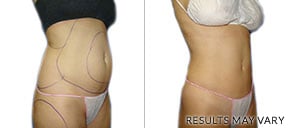Sometimes we get questions about whether fat can come back or “move around” after liposuction. It’s important to know that liposuction results are permanent, not temporary. You will not see your body “re-grow” or move fat around in response to liposuction. When we perform liposuction, cells are permanently removed, and those cells are gone forever.
How Fat Cells and Liposuction Work
There’s a good reason liposuction is one of the most popular cosmetic procedures in the United States. It produces immediate results which get even better over time, and can actually change your body shape, something that weight loss alone can’t accomplish. But it does require a commitment to a healthy lifestyle in order to maintain the results. Let’s talk about how fat cells – and liposuction – work.
Fat cells grow and shrink in size in response to weight gain
According to the most recent research, adult humans have a set number of total fat cells or adipocytes. This number is determined by your personal genetic makeup and does not change. Once the body is fully grown, the total number of fat cells does not change. So why don’t your pants from high school fit? Well, that’s because fat cells don’t stay the same size. When we gain or lose weight, our fat cells grow or shrink accordingly.
Your body has a set number of fat cells that shrink or grow in size in response to weight gain, and you can’t increase or decrease the total number of fat cells – except in two very special circumstances.
The first exception is with extreme weight gain. If existing fat cells reach their maximum size, fat cells will divide to create new fat cells.
The other exception is (you guessed it) liposuction, which can reduce the total number of fat cells in your body by physically removing them. Liposuction permanently removes fat cells from specific areas of the body through a suction tube called a cannula. (CoolSculpting also reduces the total number of fat cells through freezing).
Cell Death and Replacement
Now, here’s where the confusion can start. Fat cells don’t last forever. Every year, the body creates new fat cells to replace old cells that have died. So, the body is always creating new fat cells – but the total number of fat cells in the body stays constant. As one cell dies, another takes its place.

Once removed, fat doesn’t grow back. So, if you reduce the total number of fat cells in your body through a procedure like liposuction, your body will not regenerate these cells. They are gone forever. With liposuction, you will always see a reduction in total fat cells, and the results you see are permanent – as long as you maintain them.
Maintaining Your Results
There’s one more potential point of confusion that we see in the office, and that’s with post-lipo weight gain. The ideal candidate for liposuction is someone in good health whose weight is relatively stable. Liposuction permanently removes fat cells, but that doesn’t guarantee that you’ll have your post-lipo body forever.
Liposuction changes your body shape by removing fat in certain areas. If you do gain weight after lipo, you’ll still maintain the same body shape. For example, if you have abdomen lipo then gain weight, your belly will still be flatter than it would have been at that weight.
It’s important to maintain your results through diet and exercise.
If you do gain weight after lipo, areas not treated with liposuction may be more noticeable in comparison. The good news is that diet and exercise can return you once again to your post-lipo body.



